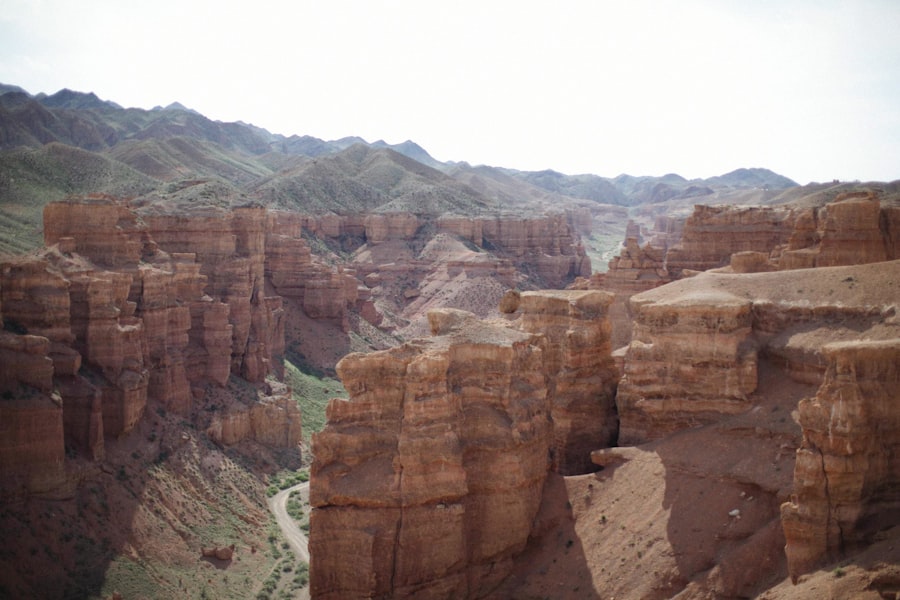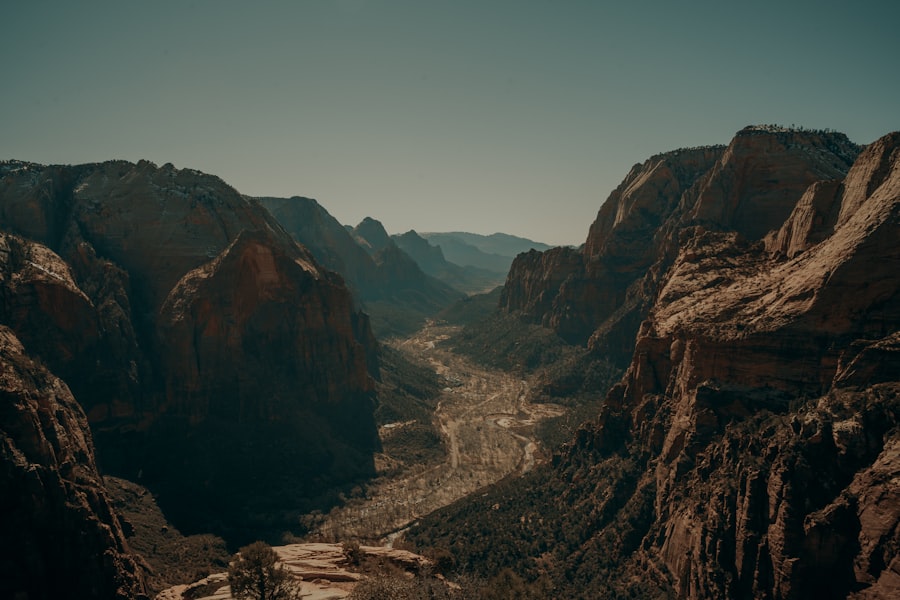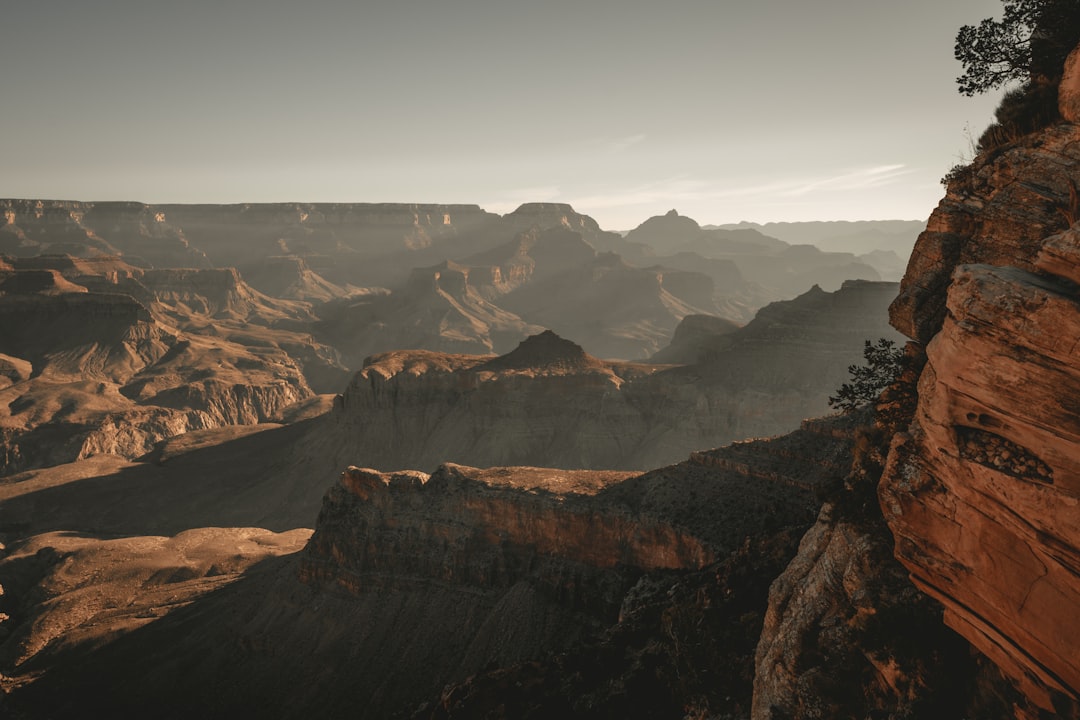The Grand Canyon stands as one of the most remarkable geological formations on Earth, a testament to the power of natural forces over millions of years. Carved by the relentless flow of the Colorado River, this immense chasm stretches approximately 277 miles in length, reaching depths of over a mile in some areas. The canyon’s walls reveal a stunning array of rock layers, each telling a story of the Earth’s history, from ancient seas to volcanic activity.
The intricate patterns and colors of the rock formations, ranging from deep reds to vibrant oranges and subtle browns, create a visual feast that captivates geologists and tourists alike. The formation of the Grand Canyon is a complex tale of erosion, sedimentation, and tectonic activity. The Colorado River began its journey through the region around six million years ago, gradually carving its way through layers of rock that date back nearly two billion years.
This ongoing process has not only shaped the canyon’s breathtaking landscape but has also exposed fossils and minerals that provide insight into the planet’s geological past. The Grand Canyon serves as a living laboratory for scientists, offering invaluable information about the Earth’s evolution and the forces that continue to shape it.
Key Takeaways
- The Grand Canyon is a geological marvel, showcasing millions of years of Earth’s history through its rock formations.
- Visitors can enjoy breathtaking views from the rim, offering stunning panoramas of the canyon’s vastness and depth.
- The canyon has a rich cultural history, with evidence of human presence dating back thousands of years.
- The diverse flora and fauna of the canyon provide a thriving ecosystem, with unique plant and animal species.
- Exploring the Colorado River offers a unique perspective of the canyon’s beauty and power, with opportunities for rafting and kayaking.
The Breathtaking Views from the Rim
Visitors to the Grand Canyon are often left speechless by the breathtaking views that await them at the rim. Numerous viewpoints, such as Mather Point and Yavapai Observation Station, provide panoramic vistas that stretch for miles, showcasing the canyon’s vastness and intricate beauty. The interplay of light and shadow across the canyon walls creates a dynamic landscape that changes throughout the day, offering a different experience with each passing hour.
Standing at the edge of the canyon, one can feel a profound sense of awe and insignificance in the face of such grandeur. The sheer scale of the canyon can be overwhelming, with its steep cliffs and expansive views that seem to stretch into infinity.
For many, this experience is not just about visual beauty; it is also about connecting with nature on a deeper level. The tranquility found at the rim allows for moments of reflection and appreciation for the natural world, making it a cherished destination for those seeking solace or inspiration.
The Rich Cultural History of the Grand Canyon

The Grand Canyon is not only a geological wonder but also a site steeped in rich cultural history. For thousands of years, Indigenous peoples have called this region home, with tribes such as the Havasupai, Hopi, Navajo, and Hualapai holding deep spiritual connections to the land. These communities have passed down stories and traditions that reflect their relationship with the canyon, viewing it as a sacred place filled with meaning and significance.
Their histories are woven into the very fabric of the canyon, with ancient petroglyphs and archaeological sites serving as reminders of their enduring presence. In addition to Indigenous cultures, European explorers began to document the Grand Canyon in the 19th century. John Wesley Powell’s expedition in 1869 marked a significant moment in American history, as it was one of the first comprehensive explorations of the canyon.
Powell’s detailed accounts and maps opened up new avenues for understanding this natural wonder and contributed to its eventual designation as a national park in 1919. Today, visitors can explore various cultural exhibits at park visitor centers that highlight both Indigenous heritage and historical exploration.
The Diverse Flora and Fauna of the Canyon
| Category | Metrics |
|---|---|
| Plant Species | Over 1,500 species |
| Animal Species | More than 400 species |
| Endemic Species | Approximately 90 species |
| Conservation Status | Several endangered and threatened species |
The Grand Canyon is home to an astonishing diversity of flora and fauna, making it a vital ecological zone within the American Southwest. The varying elevations and microclimates within the canyon create distinct habitats that support an array of plant species. From desert scrub at lower elevations to lush forests at higher altitudes, each ecosystem contributes to the overall biodiversity of the region.
Iconic plants such as the towering ponderosa pine and vibrant wildflowers add color and life to the landscape, while unique species like the Grand Canyon yucca thrive in its arid conditions. Wildlife also flourishes within this remarkable environment. The canyon is inhabited by over 447 species of animals, including mammals, birds, reptiles, and amphibians.
Visitors may encounter mule deer grazing along trails or spot California condors soaring overhead—an endangered species that has made a remarkable recovery thanks to conservation efforts. The diverse habitats within the canyon provide essential resources for these animals, allowing them to thrive in an otherwise harsh landscape. This rich tapestry of life underscores the importance of preserving such ecosystems for future generations.
Exploring the Colorado River
The Colorado River is not only responsible for carving out the Grand Canyon but also serves as a lifeline for adventure seekers and nature enthusiasts alike. Rafting down this iconic river offers an exhilarating way to experience the canyon’s grandeur from a unique perspective. As paddlers navigate through thrilling rapids and serene stretches of water, they are treated to stunning views of towering cliffs and hidden alcoves that are inaccessible by foot.
Each bend in the river reveals new wonders, from ancient rock formations to lush riverbanks teeming with life. For those who prefer a more leisurely exploration, guided river tours provide opportunities to learn about the canyon’s geology and ecology while enjoying its beauty. These excursions often include stops at significant landmarks and hidden gems along the riverbank, allowing participants to immerse themselves in both adventure and education.
Whether one is seeking adrenaline-pumping thrills or tranquil moments on the water, exploring the Colorado River is an unforgettable experience that showcases another facet of this natural wonder.
The Thriving Ecosystem of the Inner Canyon

Delving deeper into the Grand Canyon reveals a thriving ecosystem within its inner reaches. This area is characterized by steep cliffs, narrow gorges, and lush vegetation that create a unique microenvironment distinct from the rim above. The inner canyon is home to diverse plant communities that flourish in its sheltered nooks and crannies, providing habitat for various animal species.
This rich biodiversity is supported by seasonal rainfall and runoff from higher elevations, which nourishes both flora and fauna. The inner canyon’s ecosystem plays a crucial role in maintaining ecological balance within this vast landscape. Species such as bighorn sheep can often be spotted navigating rocky terrain while seeking food among shrubs and grasses.
Additionally, numerous bird species find refuge in this area, including peregrine falcons and various songbirds that thrive in its varied habitats. The intricate web of life within the inner canyon highlights its importance as a sanctuary for wildlife and underscores the need for conservation efforts to protect these delicate ecosystems.
The Hidden Waterfalls and Springs
Among its many secrets, the Grand Canyon conceals hidden waterfalls and springs that add to its allure. These natural wonders can be found tucked away in remote corners of the canyon, often accessible only by hiking trails that lead adventurers off the beaten path. One such gem is Havasu Falls, renowned for its striking turquoise waters cascading over red rock formations—a breathtaking sight that draws visitors from around the world.
The vibrant colors contrast beautifully with the surrounding landscape, creating an oasis-like atmosphere that feels almost otherworldly. In addition to Havasu Falls, numerous other springs dot the canyon’s landscape, providing vital water sources for both wildlife and hikers alike. These springs often create lush vegetation in otherwise arid areas, attracting various animal species seeking hydration and shelter.
Discovering these hidden waterfalls can be a rewarding experience for those willing to venture into less-traveled areas of the canyon, offering moments of tranquility amidst nature’s splendor.
The Ancient Rock Formations and Fossils
The Grand Canyon’s walls are not just visually stunning; they also serve as a geological archive containing ancient rock formations and fossils that tell stories of Earth’s distant past. The layers of sedimentary rock exposed within the canyon reveal a timeline spanning nearly two billion years, showcasing significant geological events such as volcanic eruptions and shifts in sea levels. Each stratum holds clues about past environments, allowing scientists to piece together how life on Earth has evolved over millennia.
Fossils found within these rock layers provide further insight into ancient ecosystems that once thrived in this region. From marine creatures that inhabited prehistoric seas to land-dwelling dinosaurs that roamed during different geological periods, these remnants offer glimpses into life long before humans arrived on Earth. The study of these fossils not only enhances understanding of evolutionary processes but also emphasizes the importance of preserving such sites for future research and education.
The Spectacular Sunsets and Night Skies
As day transitions into night at the Grand Canyon, visitors are treated to some of nature’s most spectacular displays—sunsets that paint the sky with vibrant colors and night skies filled with stars. Watching the sun dip below the horizon casts warm hues across the canyon walls, transforming them into a canvas of reds, oranges, and purples that seem almost surreal. This daily spectacle draws crowds eager to witness one of nature’s most beautiful performances.
Once darkness falls, the Grand Canyon reveals another layer of its beauty: an expansive night sky brimming with stars. With minimal light pollution in this remote area, stargazers can marvel at constellations and celestial phenomena that are often obscured in urban settings.
For many visitors, experiencing both sunset and stargazing at the Grand Canyon becomes a cherished memory—one that encapsulates nature’s ability to inspire awe.
The Adventure of Hiking and Backpacking
Hiking through the Grand Canyon offers an unparalleled opportunity to connect with nature while exploring its diverse landscapes up close. Numerous trails wind their way through this vast expanse, catering to hikers of all skill levels—from leisurely strolls along rim paths to challenging descents into the inner canyon. Popular trails like Bright Angel Trail provide access to stunning viewpoints while allowing adventurers to immerse themselves in breathtaking scenery along their journey.
For those seeking a more immersive experience, backpacking trips into the heart of the canyon offer an adventure like no other. Campers can set up tents beneath towering cliffs or beside tranquil streams while enjoying solitude away from crowded viewpoints. These multi-day excursions allow hikers to discover hidden gems—such as secluded waterfalls or pristine beaches along the Colorado River—while forging deeper connections with both nature and themselves.
Each step taken along these trails reveals new wonders waiting to be discovered.
The Spiritual and Inspirational Power of the Grand Canyon
Beyond its physical beauty lies an intangible quality that many visitors find deeply spiritual or inspirational about the Grand Canyon. For countless individuals—whether they are Indigenous peoples who have long revered this land or modern-day travelers seeking solace—the canyon serves as a powerful reminder of nature’s grandeur and resilience. Its vastness evokes feelings of humility while simultaneously igniting creativity within those who stand before it.
Artists, writers, and thinkers have drawn inspiration from this majestic landscape throughout history; many have sought refuge here to reflect on life’s complexities or find clarity amidst chaos. The sheer scale of the canyon encourages introspection while inviting contemplation about humanity’s place within nature’s intricate tapestry. As visitors leave behind their everyday lives to immerse themselves in this extraordinary environment, they often carry with them newfound perspectives shaped by their experiences at one of Earth’s most awe-inspiring wonders—the Grand Canyon itself.
In the fascinating exploration of the Grand Canyon’s hidden mysteries, the article “Grand Canyon Secrets Revealed” delves into the lesser-known aspects of this natural wonder, uncovering stories and geological marvels that have remained shrouded in mystery for centuries. For those intrigued by the enigmatic and the unexplained, a related article on X File Findings offers further insights into the secrets of the Grand Canyon, providing a deeper understanding of its historical and cultural significance. This resource is a treasure trove for enthusiasts eager to learn more about the canyon’s hidden tales and the ongoing discoveries that continue to captivate researchers and adventurers alike.
WATCH THIS! 👺 The Grand Canyon Cover-Up: Did the Smithsonian Hide Evidence of Giants?
FAQs
What are some of the secrets of the Grand Canyon?
Some of the secrets of the Grand Canyon include hidden waterfalls, ancient fossils, and mysterious caves that have yet to be fully explored.
Are there any hidden waterfalls in the Grand Canyon?
Yes, there are several hidden waterfalls in the Grand Canyon that are not easily accessible to the public. Some of these waterfalls are only visible from certain vantage points or require a strenuous hike to reach.
What kind of ancient fossils have been found in the Grand Canyon?
The Grand Canyon is home to a wide variety of ancient fossils, including those of marine creatures, plants, and early reptiles. These fossils provide valuable insights into the geological history of the area.
Are there any mysterious caves in the Grand Canyon?
Yes, there are several mysterious caves in the Grand Canyon that have not been fully explored or mapped. These caves are often difficult to access and are home to unique geological formations and ecosystems.
What other secrets are there to discover in the Grand Canyon?
In addition to hidden waterfalls, ancient fossils, and mysterious caves, the Grand Canyon also holds secrets in its rock formations, Native American history, and ecological diversity. Exploring these aspects of the canyon can reveal even more hidden treasures.
